The NFT art market has rapidly evolved, showcasing remarkable pieces of digital art while providing creators and collectors an opportunity to transact in a decentralized manner. However, a significant challenge that persists in the NFT space is liquidity. High-value art pieces tend to be highly illiquid, and the bulk of the liquidity is often provided by a handful of significant collectors (whales), leading to limited market depth and high price volatility.
As NFT platforms resort to incentivizing whales to provide liquidity, only for these whales to dump their art to farm, collectors have seen prices drop up to 90%.
To address this issue, this proposal aims to incorporate DeFi-inspired mechanisms, such as bonding and protocol-owned liquidity (POL), to create a more fluid and robust marketplace for NFT art. The goal is to strike a balance between maintaining the uniqueness and value of individual art pieces and ensuring a more liquid and stable market for creators and collectors.
POL addresses the "mercenary liquidity" problem, where protocols have to offer continually increasing incentives to attract and retain liquidity providers. This can lead to a dilution of token value and the potential for liquidity providers to shift their resources towards more rewarding pools, resulting in instability. POL comes with risks, including dependence on users bonding at a discount to market prices, and potential negative feedback loops if sustained selling pressure is applied to the protocol's token. Success will depend on a compelling value proposition.

Bonding Mechanism:
Collectors would have the option to purchase 'Art Bonds' priced at a discount but mature over time. This system allows the early supporters of an artist or collection to enjoy a lower price while ensuring a steady influx of funds to the artists and the liquidity pool over a specified period. The NFT platform could introduce a bonding mechanism where users can buy these tokens at a discount in exchange for providing liquidity (in the form of ETH, DAI, or other tokens) to the platform. This would allow the NFT platform to accumulate a treasury of assets.
Protocol-Owned Liquidity:
The assets accumulated in the treasury could then be used by the protocol to provide liquidity to the token market, reducing reliance on external liquidity providers (i.e., whales). To further enhance liquidity, a portion of the sales revenue from each NFT sale could be used to establish a liquidity pair with curated art collections.
Dutch Auction Mechanisms:
We suggest the continued use of Dutch auction mechanisms, as it's an effective way to discover the fair price for a unique, non-fungible asset such as digital art. However, by augmenting the Dutch auction with the bonding mechanism and POL, we can significantly improve market depth and price stability.
Premium = reliant on the perceived value of the art collections backing the token.

